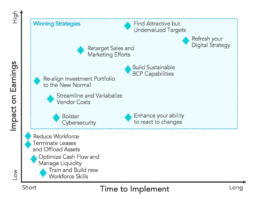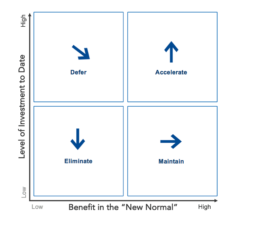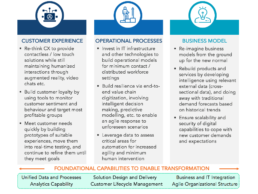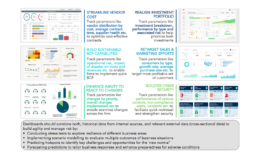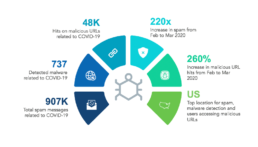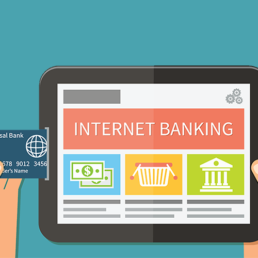As COVID-19 impacts all aspects of life, there appears to be general agreement in the global business community – nothing is going to be the same. As the new normal is emerging, a different way of operating is needed.
It is increasingly evident that:
- A V-shaped economic recovery is less likely and that we are headed for a longer Nike Swoosh recovery. Thus, firms that want to win, need to predict, embrace and leverage the evolving conditions quickly.
- The pandemic, and its economic impact varies and will continue to fluctuate by geography, by industry, by the individual business’ resiliency, by channel Precisely targeting your business strategy and investments will be paramount to making winning bets.
- While the pandemic initially disrupted the supply side, demand for a variety of legacy products and services is likely to stay low. Just like restaurants need to figure out how to be profitable with half the indoor-seating, businesses must now figure out how to maximize profits with reduced demand for products and services that were profitable just 2 months ago.
- Individual customers will be impacted very differently based on the severity of the pandemic in their region, their business model, and financial health. Some of them will not survive the economic disruption, but others will be loyal for a long time if treated with empathy and care.
- The economy shall remain virtual and contactless for a while. Finally, after a couple of decades of trying to go paperless, the current environment is ripe for digitizing the lingering customer interactions.
Most businesses have managed to respond to the immediate disruption. Mandatory social distancing has forced firms to re-shape their working set-ups. The social contract between employers and employees is undergoing significant changes with focus on remote working, job flexibility, employee health and resource back-ups. Complementary investments in security, connectivity, communication and collaboration tools is also in place.
However, this crisis offers an opportunity for the bold to come out on top. Winston Churchill famously said – ‘Never waste a good crisis’. Institutions that quickly reinvent themselves to make the most of evolving customer preferences and economic opportunities, will disproportionally succeed. This is the time for strategic winning bets.
Exhibit 1: Key Winning Strategies
1. STREAMLINE & VARIABLIZE VENDOR COSTS
Given the sudden change in economic outlook, most businesses were not prepared for it. Most had invested in building economies-of-scale, and knowingly or unknowingly built a large and complex fixed cost base. Business models were designed for growth and speed-to-market, not efficiency and financial flexibility. It will not be enough for firms to tweak their business model; instead, they will need to rethink it.
We recommend being aggressive in reducing costs not only to free up capital but also to invest in capabilities for the “new normal”. For example, we have found that IT costs can typically be reduced by 20-30% quickly.
Given the current outlook, financial flexibility is also key. For non-personnel costs, this means reducing minimum commitments, transitioning from fixed-fees to pay-for-performance, and transitioning to true shared incentives with suppliers.
Firms must create robust cost reduction plans keeping the following considerations in mind:
Prioritize based on immediate needs. Focus should be on costs that can actually be removed, not just frozen for the current period, only to come back further down the line.
Focus on cash flow items. Target items that have a real cash impact on financials rather than non-cash items like depreciation. For example, selling and leasing back assets can provide real cash savings, as opposed to reducing on-premise software licenses.
Revisit vendor base. Select suppliers carefully since some will not make it through the economic stress e.g. vendors with high fixed costs, manual processes and dwindling sales prior to the pandemic are most vulnerable.
2. RE-ALIGN INVESTMENT PORTFOLIO TO THE NEW NORMAL
Given the sudden and dramatic shift in customer demand, business outlook and future needs, this is the time to revisit all investments.
Executives may be tempted to shut down most investments in an attempt to shore up the business. That would be a mistake. While cost containment is crucial, executives have an opportunity to prioritize targeted investments that can help position the business to succeed as the market recovers. There’s no point in winning the battle but losing the war.
While deciding on which investments to prioritize, an initial decision can be made using the following considerations:
- Eliminate projects with low level of investment and benefit in the new normal. In case of reversible investments, they should be unwound, before considering more permanent and potentially damaging changes.
- Maintain projects with high level of benefit but low level of investment until cash flows can be streamlined to make further investments, for future profitability.
- Defer projects where high level of investments has already been made but they are less beneficial in the new scenario.
- Accelerate projects with high level of benefit and investment as these will help pivot to the new business reality.
Exhibit 2: Prioritize Investments for the “New Normal”
3. BUILD SUSTAINABLE BCP CAPABILITIES
Compounding the current challenge, winter will bring renewed crisis for many countries. Hence, current BCP efforts now need to be bolstered to sustain in the “new normal”.
- While most firms have implemented urgent BCP fixes, additional gaps are likely to be uncovered (e.g. year-end, seasonal, event-driven conditions).
- Several of the current quick fixes will need long-term solutions as “new normal” continues.
- Pandemic-specific upgrades will be required for current BCPs (e.g. governance, documentation, processes etc.)
- BCP plans will need to be tested and re-validated for suppliers and for end-to-end business processes.
- Regulators and institutional customers will soon seek evidence of a robust, and continually tested Pandemic BCP capability.
We are also finding that such an exercise is uncovering long-ignored inconsistencies in criticality and prioritization across the organization. Processes, IT applications, IT incidents, vendors etc. that were assumed to be resilient, weren’t always. Thus, in addition to bolstering the criticality assignments, SLAs, governance, processes etc., it is important to automate the process and build real-time resiliency-monitoring dashboards across all services. Such “easy to access” real-time dashboards should track the right set of metrics – status, service levels, capacity, areas of risk, and so on.
Additionally, supply chains for financial institutions are now vulnerable to the economic disruption. The new supply chain must consider the following:
Re-align vendor portfolio to maintain viability. Evaluate external partners and suppliers (e.g. infrastructure support partners, SaaS providers etc.) to continue to monitor their current situation and create scenario plans and strategies for alternative sourcing, new vendors and lead-time impacts.
Employ multi-vendor agreements to reduce risk. Shift from fixed monopolistic contractual agreements to multi-vendor contracts, providing more agility and flexibility to adjust services and adapt to changing business needs.
Leverage data to improve visibility. Analyze internal and external data to stay a step ahead of supply chain disruptions. This involves harnessing ML / AI for predictive and prescriptive analytics. These tools can deliver early-warnings, model risk scenarios and develop pre-programmed responses. This also entails updating planning parameters and objectives, since old assumptions are no longer valid.
4. RETARGET SALES & MARKETING EFFORTS
Today, the health of various customer segments varies dramatically by sector. Industries that depend on in-person shared experiences (e.g. cruise lines, concerts and airlines) are likely to take a while to regain profitability. On the other hand, online businesses are seeing a new wave of customer traffic. Additionally, the buying power of customers will vary dramatically based on their income generation capability, financial health, and ability to pivot to the new normal etc. Thus sales & marketing functions need to refresh their predictions of the willingness and ability of individual customers and prospects.
Moreover, since customer behavior is in the midst of a dramatic shift, marketers cannot rely on past truths. Most sales and marketing analytics depended on historic performance. Since we are in unprecedented times, most of these analytical models have lost their predictive power. Thus, it is critical for firms to build new analytical models that leverage current cross-sectional data, rather than the traditional longitudinal data.
Finally, given travel restrictions, the operating model for sales & marketing needs to be re-optimized. Clients that historically were served through field sales and branches, may now need more tele-sales, marketing and digital engagement.
5. REFRESH YOUR DIGITAL STRATEGY
According to the Brookings Institution, the pace of automation has increased through each of the last three recessions. The current recession is no different. Online sales and service channels are experiencing a dramatic spike in traffic – in China alone, there has been a 2-3x jump in use of such channels. While most organizations are pursuing digitization, a vast majority are still in the early stages of their transformation. Firms need to focus on short-term needs as well as developing a clear perspective of the business’ longer-term digital future. It is now time for firms to refresh and accelerate their digital strategy.
There is a need to re-think customer experience, streamline existing processes and reimagine business models to meet new market requirements and stay competitive in the post-COVID-19 world. Meeting customers at their preferred channels, developing digital and contactless solutions, enabling analytics-based decision making, and ensuring scalability of digital capabilities will need to become common practice.
Finally, many consumers will switch providers based on their experiences during the crisis, with a shift towards digital disruptors. Firms must rapidly implement holistic digital solutions to retain customers.
Exhibit 3: Key Considerations for a Digital Transformation
6. FIND ATTRACTIVE BUT UNDERVALUED ACQUISITIONS
The pool of acquisition targets always swells in recessions. A recalibrated acquisition strategy can be a competitive advantage for organizations willing to move fast in this environment. The fall in valuation of many start-ups due to the economic downturn and slow growth across IT services, provides firms with deeper pockets of opportunity to augment their capabilities, expand their addressable market, and grow their top line.
However, given the market conditions, it is important to do thorough due diligence on the health of the target’s customer base, its ability to digitize its business model, and the implications of the current environment on its accessible market opportunity.
7. ENHANCE YOUR ABILITY TO REACT TO CHANGES
In the ever-evolving new normal, organizations must be agile. There is a heightened importance of quick decision making, increased speed-to-market, and adaptability to unforeseen conditions.
For large enterprises, a pre-condition to agility, is visibility. Real time digital dashboards play a critical role in providing timely insights and alerts about potential business opportunities and issues.
Additionally, firms must overcome the inertia of legacy hierarchical organizational structures that render inadequate in times of crisis. The pandemic will encourage firms to adopt newer organizational structures focusing on flatter models with limited hierarchy and greater flexibility. Additionally, holacratic models are also gaining relevance that enable employees to come together in self-organized teams to achieve specific goal-oriented tasks. At the end of the task, the teams dissolve and employees become available to become part of newer teams with newer roles. These structures will enable organizations to deploy dynamic agility in times of uncertainty.
Exhibit 4: Real-Time Digital Dashboards for Business Intelligence
8. BOLSTER CYBERSECURITY
In recent weeks, we have seen an increase in COVID-19 focused social-engineering cyberattacks, which have exploited the current confusion and decreased the effectiveness of the “human firewall”. CIOs, working with their chief information-security officers must shore up their cyber protocols to deal with compromised credentials and data, as well as intellectual-property theft, fraud, and other crimes.
There is a need to implement a holistic cyber security plan to protect business, incorporating the following measures:
Manage risks associated with cloud usage. Due to a shift towards remote working, many firms have shifted from on-premise systems to cloud based platforms, in an attempt to avoid disruptions to business operations. This move has increased the risk of attacks and cyber security measures must be complemented with implementing best practices for secure cloud usage. Some of them include user access control, secure server connections through SSH keys, system insight monitoring, patch monitoring etc.
Optimize threat detection using tech-enabled cyber security tools. Threat detection and associated response should be supported by next-generation technologies like big data, AI and ML to respond to adverse conditions at machine speed, without human involvement. Further, organizations should update their insurance plans to protect against losses from cyberattacks incurred during the pandemic.
Support altered working environments with preventive security protocols. Real time guidelines should be shared, and mechanisms need to be built to reinforce policies that must be followed. Updates to remote access and bring-your-own-device (BYOD) policies should be considered to establish hygiene protocol for new remote working set-ups
Exhibit 5: COVID-19 related Cyber Threats in Q1 2020
In Summary…
Nothing is going to be the same as the economy re-opens. Businesses should think not just about how to ‘survive’ the disruption, but how best to ‘thrive’ in the opportunities coming available.
Business strategies need to be refreshed, not based on what has worked in the past, but with an eye to pivot to the new normal. This pivot has to start by bolstering BCP and cybersecurity to protect the current business. In parallel, firms need to focus on streamlining vendor costs, proactively managing upcoming liabilities (e.g. credit defaults), and pivoting to customers / investments that will be profitable in the new normal. Finally, profits released from these near-term actions should then be invested in acquiring undervalued targets and re-imagining digital business models.
Simply tweaking operations, strategies and investments will not suffice; firms must make transformative changes before competitors do.
COVID-19 should be viewed as a catalyst, rather than disruptor, pushing the envelope on the long overdue digital era.
